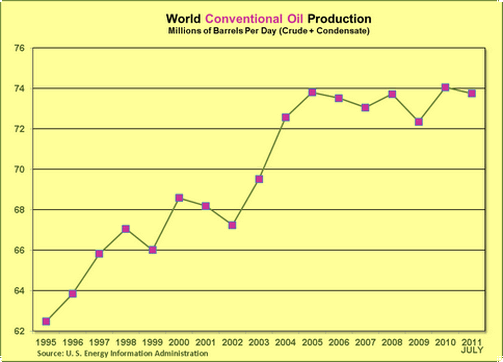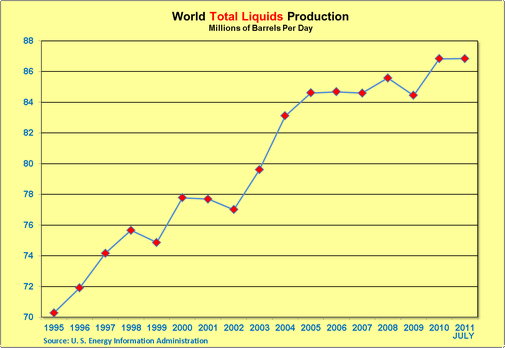|
Time to Worry: World Oil Production Finishes Six Years of No Growth
As oil prices rose ever higher in the last decade, the optimists kept predicting rising production capacity and plummeting prices. Looks like they got it wrong.

We are entering what may be the longest stretch of no growth in world oil production since the early 1980s. But the reasons for that lack of growth differ in ways that ought to make us all uncomfortable.
Starting in 1980, production slumped because for the first time in history people needed less oil. After the huge oil price increases in the 1970s, cars suddenly got smaller. People became more careful about combining trips to save gas. A lot of people switched their home heating to natural gas which was considerably cheaper than heating oil. And, in the United States the Congress severely restricted the use of oil for new electric power generating plants. Those using oil began to switch to cheaper natural gas and coal. The whole globe went on an energy efficiency binge.
Beyond this, the world went through two recessions, one in 1980 and the second in 1981-82 which turned out to be the worst since World War II (until the current one). That curbed oil demand as economic activity sank. All the while, large oil discoveries in Alaska and the North Sea and furious drilling elsewhere produced a glut of capacity that sent prices from a high near $40 a barrel in early 1981 to about $16 a barrel six years later. As it turned out, all of these factors combined to keep world oil production below its 1980 peak until 1988.
Fast forward to 2005 when conventional oil supplies stopped growing and then fluctuated between 73 million and 74 million barrels per day on an annual basis through 2010. (Production averaged 73.8 million barrels per day this year from January through July, the last month for which data is available.) The chain of events following the 2005 peak are both different and worrisome. Following the cessation in growth of conventional oil supplies, the world economy continued to grow until the end of 2007 when it slipped into recession. Prices peaked in July 2008 at around $147 a barrel.
But then they plunged to around $35 a barrel in December 2008 as the world sank into an economic slump worse than anything since The Great Depression. With it oil demand and production slumped as well. Then the price did something that few people expected. It bounced back even as overall global economic recovery remained sluggish. Rapid recovery in the Far East, however, created robust demand for oil even as North American and European countries remained locked into an unusually tepid rebound. As a result, last spring prices for Brent crude vaulted above $125.
Six years from the ostensible topping out of conventional petroleum production, prices remain considerably higher. Oil prices finished 2005 around $50 a barrel. As of this writing, they are around $90 for Nymex crude and around $110 for Brent crude. This, of course, is exactly the opposite of the trend which occurred in the six years following the 1980 peak. Today, the often predicted rise in conventional supplies has failed to materialize, flummoxing the optimists so much that they simply ignore the data and talk of wonders yet to come.

Astute observers will say that this is not the whole picture. After all, high prices for a resource also stimulate substitutes for that resource. And, true enough, the substitutes for oil are starting to arrive. But the big question is: Will they arrive soon enough and at a scale that is large enough to make up for the current stagnation in the rate of oil production and the eventual and certain decline in that rate? So far the answer is no.
What the U.S. Energy Information Administration, which is the statistical arm of the U.S. Department of Energy, used to call 'total oil production' has now morphed into so-called 'total liquids production.' It's a tacit admission that conventional oil supplies cannot meet all our needs. But even total liquids production--which includes ethanol, biodiesel and natural gas liquids--has moved up only a paltry 2.6 percent during the entire period from the end of 2005 to today. Hence, the continuing high prices for liquid fuels.
Now, it's not as if high prices haven't sent people looking for more oil and working on more substitutes. The problem is that all of this activity is facing a considerable headwind. It's called depletion. And, as they say in the oil patch, depletion never sleeps. It's going on in every operating well in every country around the clock, 365 days a year. Estimates suggest that the decline in current production capacity might be around 4 percent per year. That means that 4 percent of the current production capacity for oil must be replaced each year just to break even. And, of course, to grow supplies, new production capacity must exceed this amount. But it hasn't, and oil substitutes haven't really grown by any significant amount in the last six years either.
The media loves to announce new seemingly large discoveries of oil as if they are the solution to what is really an unfolding liquid fuels crisis. They point to the Tupi field off Brazil which is purported to have 8 billion barrels of oil in it. And, they point to discoveries in the deepwater Gulf of Mexico thought to contain between 3 and 15 billion barrels. And, they point to the 4 billion barrels in the Bakken Shale in North Dakota. It all sounds like a lot. When I ask audiences how long a billion barrels of oil will last the world at current rates of consumption, I often get replies that range anywhere from three months to 5 years. The correct answer is 12 days. Just multiply these multi-billion-barrel discoveries by 12, and you'll realize right away that they are not going to overcome the constraints we are experiencing in oil supplies.
Something else has to give, and that something is probably going to be consumption. Either consumption will decline as the result of a new slump in the economy--a slump partly caused by high oil prices--or it will decline because high prices will encourage people to be more frugal in their energy use. Many of the poorest in the world will no doubt have to do without.
There is a third way. We could now begin a crash program to reduce our consumption of oil through new efficiency standards, higher energy taxes, expansion of convenient mass transit, and new energy-wise personal habits. All this would hurry the transition away from an energy source that will only become more problematic over time.
The optimists would have you ignore the oil production and price data of the last six years. It's as if they are channeling the late comedian Richard Pryor known for his trademark phrase: 'Who you gonna believe? Me or your lying eyes?' After six years of flat oil production in the face of record prices, it's time to start believing your lying eyes.
| 
